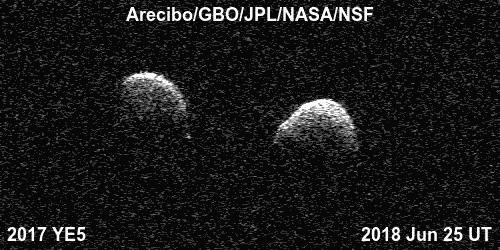Jason Davis • Jun 21, 2024
What are binary asteroids?
Binary asteroids are two asteroids that orbit each other. Their existence had long been theorized, but never confirmed, until NASA’s Galileo probe launched on a mission to Jupiter in 1989. En route to the gas giant, Galileo became the first spacecraft to visit an asteroid up close. It flew past Gaspra in 1991, followed by Ida in 1993.
Following the Ida flyby, scientists studying Galileo’s images saw a small speck next to the asteroid. It was the first proof that binary asteroids exist. They named the small world Dactyl after the mythological creatures that guarded the infant Greek god Zeus.
"It was previously thought that natural satellites of asteroids could form, but they probably weren't common," said Torrence Johnson, Galileo's project scientist, at the time. "Having found one fairly quickly, we can say that they're probably more common than previously thought."

Finding binary asteroids
Today we know of more than 500 confirmed and probable binary asteroids. They are located everywhere giant space rocks are found: near Earth, in the main asteroid belt, beyond Neptune, and more. Scientists believe as much as 16% of all asteroids are binary asteroids.
We find binary asteroids through direct imaging, radar observations, and light curves. Light curves are the most common technique, in which astronomers track the brightness of an object over time. As binary asteroids pass in front of each other, their combined brightness fluctuates predictably, indicating that what may have initially looked like a single asteroid is in fact two.

The Planetary Society’s Shoemaker NEO Grants fund efforts to find, track, and characterize near-Earth objects to help protect our planet from hazardous impacts. Many of our grant winners are skilled binary asteroid hunters. Two-time Shoemaker grant recipient Vladimir Benishek recently discovered 19 new binary asteroids over a 15-month span, using equipment he purchased through his 2018 and 2022 grant proposals.
Binary asteroid types
Binary asteroids rotate around their barycenter, or common center of mass. Some binary asteroids like Ida and Dactyl have lopsided size ratios, and one object orbits the other.
Other binaries are closer in size, with one object still noticeably larger than the other. This is the case for Didymos and Dimorphos, which NASA’s DART mission targeted in its successful planetary defense test in 2022.
When the Lucy spacecraft flew past asteroid Dinkinesh in 2023, it found that Dinkinesh had a smaller companion, which has since been named Selam. Selam is a contact binary: two objects that are touching each other. Another example of a contact binary is Arrokoth, the Kuiper Belt world visited by the New Horizons spacecraft in 2019.
Still other binaries are nearly equal in size, such as double asteroid 2017 YE5. An observatory that received Shoemaker grant funding made the initial discovery of 2017 YE5, while another Shoemaker winner helped confirm its double nature in 2018.

Asteroid systems aren’t limited to binaries, either. There are at least 15 known triple asteroid systems, and astronomers announced a quadruple asteroid system in 2022.
How do binary asteroids form?
Binary asteroids form in different ways, depending on where they are located and how big their starting components are. Our knowledge of how binaries form is biased toward asteroids closer to Earth because they are easier to study.
Large, main-belt binary asteroids most likely form through collisions. When two objects collide, material knocked off one or both asteroids can reaccumulate to form a new asteroid.
A leading formation theory for binary near-Earth asteroids, and small, inner, binary main-belt asteroids, is the YORP (Yarkovsky-O’Keefe-Radzievskii-Paddack) effect. An asteroid’s sunlit side absorbs solar radiation. As that side rotates into darkness, some of the absorbed radiation escapes back into space, giving the asteroid a small push. Variations in reflectivity across an asteroid’s surface can cause this absorption and emission process to increase the asteroid’s spin, until it begins to shed material or even break apart. The lost material can accumulate into a companion asteroid.

Still other binary near-Earth asteroids can form through tidal disruption, where an asteroid passes by a gravitational body like Earth that pulls it apart. The leftover material may then accumulate into two separate objects.
Watch out for binary asteroids
Just like their single brethren, binary asteroids can impact our planet and cause destruction. Roughly 290 million years ago, a binary asteroid struck present-day Quebec, Canada, forming two distinct craters that are now known as Clearwater Lakes. The western lake has a central ring of islands that were lifted out of the surface by the impact.

Finding, tracking, and characterizing asteroids, including binary systems, is vital for planetary defense and understanding the Cosmos. Like other small worlds, binary asteroids are made of material left over from the Solar System’s early days. By studying these celestial duos, we can safeguard our planet and piece together our origin story.
Support our core enterprises
Your support powers our mission to explore worlds, find life, and defend Earth. You make all the difference when you make a gift. Give today!
Donate

 Explore Worlds
Explore Worlds Find Life
Find Life Defend Earth
Defend Earth

